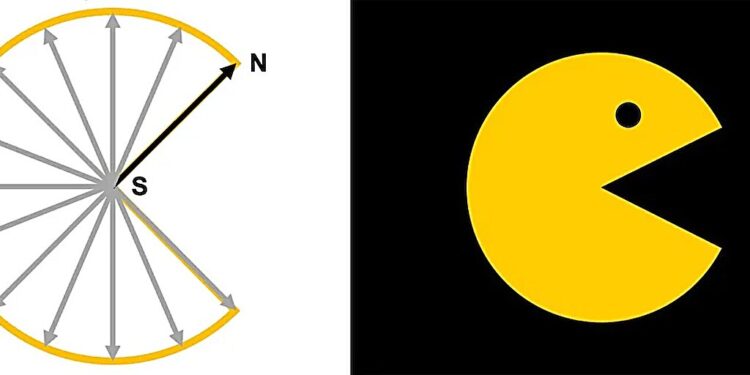The representation of the magnetic colloidal dipole orbit (left) resembles a Pac-Man shape (right). Credit: Biswal Laboratory/Rice University
Particles that are larger than ordinary molecules or atoms, but remain invisible to the naked eye, can form a variety of useful structures, including miniature propellers for microrobots, cellular probes, and steerable microwheels designed for targeted drug delivery .
Lisa Biswal’s team of chemical engineers at Rice University discovered that exposing a certain class of such particles (micron-sized beads with particular magnetic sensitivity) to a field magnetic rotating rapidly in alternation causes them to organize themselves into structures that depend on direction. or anisotropic. This discovery is important because anisotropy can be tuned to develop new customizable structures and material properties.
“Our main discovery is that by alternating the direction of rotation of the magnetic field after each revolution, we can create a potential for anisotropic interaction between particles, which has not been fully realized before,” said Aldo Spatafora- Salazar, chemical and biomolecular researcher. engineering researcher in the Biswal laboratory and one of the lead authors of a study on the research published in Proceedings of the National Academy of Sciences.
Dana Lobmeyer, the other first author of the study, explained that the particles examined in the study are collectively known as superparamagnetic colloids whose responsiveness to magnetic fields makes them a popular building block for high-performance materials equipped with tailor-made features.
“This discovery is important for the bottom-up design of advanced materials, particularly because we focused on an aspect of the interaction between colloids and magnetic fields that is typically overlooked: the magnetic relaxation time,” said Lobmeyer. , a former Rice doctoral student advised by Biswal. .
Relaxation time refers to the delay in the magnetic response of the beads to changes in field direction. The researchers hypothesized that this delay combined with the effect of the alternating magnetic field affects the interactions of the beads, causing them to organize into a two-dimensional crystal lattice and form elongated, aligned clusters in three dimensions.
Microscopy images of cluster formation (left) and graphical representation of cluster alignment (right). Credit: Biswal Laboratory/Rice University
“The delayed magnetic response, or magnetic relaxation time, of superparamagnetic beads was previously thought to be negligible, but we have found that accounting for it and coupling it with the effect of the alternating magnetic field provides a powerful way to exert control precise on the particle,” said Biswal, the study’s corresponding author and Rice’s William M. McCardell Professor of Chemical Engineering, professor of materials science and nanoengineering and senior associate dean for faculty development .
The research involved a combination of experiments, simulations and theoretical predictions. Experimentally, the team examined concentrated and diluted bead suspensions combined with alternating magnetic fields of different intensities and frequencies.
“The concentrated beads formed elongated, aligned clusters, and we analyzed how different parameters influenced their shape,” Spatafora-Salazar said. “The diluted suspensions simplified the system, allowing us to study interactions between two beads, a version of the system known as a dimer.”
Experimental insights from dimers have helped explain alignment and elongation in larger clusters. However, the experimental data only matches the simulations once magnetic relaxation time measurements (which are the subject of a separate upcoming study) are taken into account.
A fun twist on the data was the Pac-Man shape described by the distribution of a bead’s magnetization: in a magnetized state, each bead acquires a dipole, a pair of negative and positive charges like a north-south axis.
In response to a rotating magnetic field, the dipole moves like a compass needle, aligning all the balls in the same orientation. However, due to magnetic relaxation, the needle does not rotate 360 degrees, revealing what appears to be Pac-Man’s mouth when the data is mapped.
“The interactions are weakest along the mouth but strongest along the head, causing dimers and clusters to align,” Lobmeyer said. “We could not have understood this phenomenon without deviating from the traditional assumptions used to study these pearls.”
More information:
Aldo Spatafora-Salazar et al, Aligned colloidal clusters in an alternating rotating magnetic field elucidated by magnetic relaxation, Proceedings of the National Academy of Sciences (2024). DOI: 10.1073/pnas.2404145121
Provided by Rice University
Quote: Exploiting magnetic relaxation: “the Pac-Man effect” allows precise organization of superparamagnetic beads (2024, October 4) retrieved October 4, 2024 from
This document is subject to copyright. Except for fair use for private study or research purposes, no part may be reproduced without written permission. The content is provided for informational purposes only.



